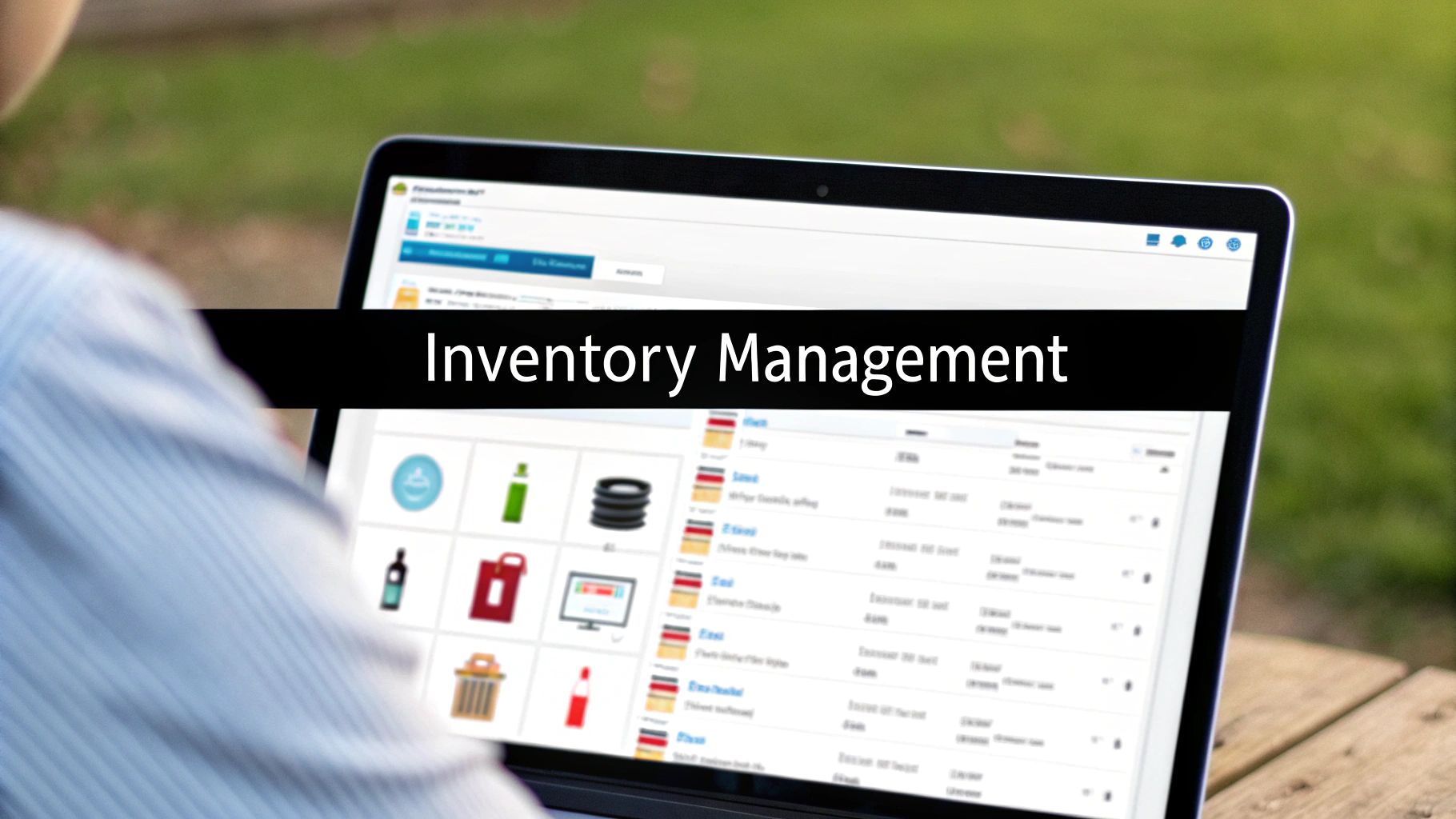Navigating the Amazon Seller Dashboard Essentials

Feeling overwhelmed by the Amazon Seller Dashboard? Many UK merchants share this sentiment. While this powerful tool can initially seem complex, understanding its core functions is essential for online selling success. This guide breaks down the key sections, offering practical tips and shortcuts from experienced sellers to help you navigate efficiently. Whether you're a beginner or managing a large product catalog, this guide helps you transform the dashboard into a strategic advantage.
Understanding the Key Sections
The Amazon Seller Dashboard is organized into several key sections, each playing a vital role in managing your online business. These sections offer a complete overview of your operations, from inventory management to sales analysis, providing a centralized platform for virtually all your selling activities.
-
Inventory: This section is your central hub for managing product listings. You can add new products, update existing listings, and track your stock levels. Efficient inventory management is vital for meeting customer demand and minimizing storage fees.
-
Orders: Track each order from placement to delivery. The Orders section allows you to manage shipping, returns, and customer communication, providing a centralized system for organization and excellent customer service.
-
Advertising: Increase your product visibility and drive sales with targeted advertising campaigns. This section enables budget management, campaign creation, and performance tracking.
-
Reports: Data-driven decisions are crucial for e-commerce success. The Reports section provides valuable insights into your sales, traffic, and customer behavior. Use these reports to identify trends, optimize strategies, and make informed business decisions.
-
Performance: Monitor your seller metrics, including customer feedback and account health. Maintaining a good performance rating is critical for building trust with customers and safeguarding your selling privileges.
-
Growth: Amazon offers resources and programs designed to help you scale your business and boost sales. This section is a valuable resource regardless of your business's current growth stage.
Prioritizing Your Dashboard Activities
With the wealth of information available, prioritizing your dashboard activities is key. Focus on the areas with the greatest impact on your business. For example, regularly monitoring your Inventory levels helps prevent stockouts and ensures you can meet customer demand. Similarly, close attention to your Performance metrics helps maintain a positive seller rating and protect your account. There are approximately 281,257 active sellers on Amazon in the UK, significantly contributing to the UK's e-commerce landscape. Find more detailed statistics here. With Amazon capturing roughly 20% of total online retail sales in the UK, competition is fierce. This emphasizes the importance of effectively using your Amazon Seller Dashboard to maintain a competitive edge.
Saving Time With Navigation Shortcuts
Experienced sellers utilize shortcuts to navigate the dashboard efficiently. Customizing your homepage with frequently used widgets provides quick access to essential information. Using the dashboard's search bar helps you quickly locate specific data or settings. These time-saving strategies free you to focus on what matters most – business growth. In the following sections, we'll explore each area of the dashboard in more detail, examining the tools and techniques to propel your success on Amazon.
Decoding Critical Metrics That Drive Sales Growth

Beyond simply tracking sales, the Amazon Seller Dashboard offers a treasure trove of data crucial for business expansion. For UK sellers aiming to optimize their performance, understanding which metrics truly matter is paramount. This section explores the most important data points within your dashboard and demonstrates how to use them for strategic decision-making. We'll also illustrate how these metrics work together to give you a complete overview of your business's health.
Key Performance Indicators (KPIs) for UK Sellers
Certain KPIs are fundamental for success as an Amazon seller in the UK. Let's explore a few of the most impactful:
-
Conversion Rate: This metric shows the percentage of product page visitors who complete a purchase. A low conversion rate could indicate issues with your product listing, pricing, or even product images. Optimizing your conversion rate directly translates to higher sales.
-
Session Metrics: These data points, which include page views and average session duration, provide valuable insights into customer behavior. Understanding how customers interact with your listings can highlight areas for improvement. For example, short session durations might suggest your product descriptions aren't compelling enough.
-
Buy Box Percentage: This metric tracks how often your offer wins the Buy Box. Securing the Buy Box is vital because it significantly affects sales. A higher Buy Box percentage means better product page placement and a greater chance of conversion.
-
Order Defect Rate (ODR): This crucial metric assesses your ability to deliver a positive customer experience. A high ODR can harm your reputation and potentially lead to account suspension. Maintaining a low ODR is essential for preserving customer trust and your selling privileges.
Benchmarks and Optimization Strategies
While overall metrics are important, understanding category-specific benchmarks offers more targeted insights. For instance, conversion rates for electronics typically differ from those for beauty products due to variations in customer behavior and research processes. Researching these nuances can help refine your optimization strategies.
The following table provides a concise overview of essential metrics and optimization tactics:
Essential Amazon Seller Dashboard Metrics
A comprehensive overview of the key performance indicators available on the Amazon seller dashboard and their significance for UK sellers
| Metric | Description | Impact on Business | Optimization Tips |
|---|---|---|---|
| Conversion Rate | Percentage of visitors who make a purchase | Directly impacts sales revenue | Improve product listings, pricing, and images |
| Session Metrics (Page Views, Session Duration) | Customer engagement with product pages | Reveals areas for improvement in content and user experience | Enhance product descriptions and page layout |
| Buy Box Percentage | Percentage of time your offer wins the Buy Box | Significantly influences sales volume | Competitive pricing and strong seller metrics |
| Order Defect Rate (ODR) | Measures customer experience issues | Impacts seller reputation and account standing | Prioritize excellent customer service and efficient order fulfillment |
By analyzing this table, UK sellers can identify areas for improvement and focus their optimization efforts.
The Amazon Brand Analytics dashboard provides valuable data for sellers in the UK, allowing you to track product performance across metrics like clicks, cart additions, and purchases. This tool offers a deeper understanding of customer engagement.
Identifying True Growth Indicators
Some metrics, while seemingly positive, may not indicate sustainable growth. A sudden spike in traffic, for example, could be due to a fleeting viral trend rather than a robust marketing strategy. Similarly, high sales of a low-margin product might not contribute significantly to profitability.
Instead of focusing on vanity metrics, prioritize those that reflect the true health and potential of your business. These include customer lifetime value, repeat purchase rate, and profit margin. By focusing on these key metrics, UK sellers can build a thriving and profitable business on Amazon. Consider resources like how to master site structure for further guidance.
Unlocking Advanced Analytics for Competitive Edge

The Amazon Seller Dashboard isn't just for checking daily sales. It's a powerful analytics engine waiting to be explored. Top UK sellers know that the real power lies in the advanced analytics tools, often overlooked by other merchants. This means going beyond basic data to discover hidden opportunities and optimize for lasting success in the competitive UK marketplace.
Utilizing Business Reports for Strategic Advantage
Business Reports, within your Amazon seller dashboard, offer a wealth of information beyond simple sales figures. This section can reveal emerging product opportunities before they become widespread.
For example, analyzing sales data combined with customer search trends can pinpoint rising demand for specific product variations or niche items. This proactive approach allows UK sellers to stay ahead of the competition and capitalize on new trends.
Additionally, Business Reports can be customized to provide insights specifically for your business needs. This allows you to focus on the most relevant data for your unique selling strategies.
Inventory Performance Index: Maximizing Efficiency and Growth
The Inventory Performance Index (IPI) is a critical metric for efficient inventory management. It identifies potential supply chain weaknesses and reveals opportunities for growth. A high IPI score indicates a well-managed inventory, reducing storage fees and maximizing profits.
However, a low IPI might suggest overstocking or slow-moving items. These can tie up valuable resources and impact your bottom line. By addressing these issues highlighted by the IPI, UK sellers can free up capital. This capital can then be reinvested in high-performing products, leading to a more streamlined and profitable operation.
Understanding UK Shopping Patterns and Consumer Preferences
The Amazon seller dashboard provides valuable data on British shopping patterns and consumer preferences. This data helps sellers make informed decisions about product development and marketing strategies. For deeper marketing insights, consider exploring tools like those found in articles about social media analytics dashboard tools.
By analyzing sales data, customer reviews, and search trends, you can determine what UK consumers are actively searching for and what motivates them to buy. Understanding seasonal buying trends allows you to anticipate demand spikes and adjust your inventory, preventing stockouts during peak seasons.
Actionable Insights for Product Development and Marketing
Combining data from Business Reports, the Inventory Performance Index, and customer behavior insights creates a comprehensive view of your business. This helps you identify which products resonate with UK consumers and which need improvement.
This knowledge allows you to adjust marketing campaigns and optimize product listings for better visibility and conversion rates. For example, if data reveals a rising demand for eco-friendly products in your category, you can incorporate this into product descriptions and target marketing efforts accordingly. This data-driven approach helps UK sellers maximize their ROI and build a sustainable business on Amazon.
Mastering Inventory Management Without the Headaches

Effective inventory management is essential for success on Amazon. Mistakes in this area can significantly impact profits. This section explores how successful UK sellers use the Amazon Seller Dashboard to transform inventory management from a challenge into a strategic advantage. We'll examine practical techniques for optimizing stock levels, forecasting demand, and ultimately, boosting profitability. Read also: How to master site structure.
Predicting Seasonal Demand Spikes in the UK
Understanding the UK market is crucial for predicting seasonal demand. British consumers have unique buying habits influenced by holidays, cultural events, and even the weather. The Amazon Seller Dashboard provides the data necessary to anticipate these fluctuations.
For example, historical sales data can reveal trends related to bank holidays, back-to-school shopping, and the Christmas rush. This allows sellers to proactively adjust stock levels to meet increased demand without overstocking.
Monitoring real-time sales data through the dashboard during peak seasons allows for on-the-fly adjustments to inventory strategy. This agility enables sellers to react quickly to unexpected changes in demand and maximize sales potential.
Preventing Stockouts and Managing Storage Fees
Stockouts can damage sales and customer satisfaction. The Amazon Seller Dashboard offers tools to avoid these costly scenarios. By setting up low stock alerts, sellers receive timely notifications when inventory dips below a specified threshold. This allows for prompt replenishment, minimizing the risk of lost sales.
Overstocking, however, leads to excessive storage fees, impacting profits. The dashboard's Inventory Performance Index (IPI) offers insights into inventory health, identifying areas for improvement. Maintaining a healthy IPI helps sellers balance having enough stock to meet demand while minimizing storage costs.
Balancing FBA and Merchant-Fulfilled Strategies
Choosing the right fulfillment strategy is essential for optimizing business operations. The Amazon Seller Dashboard facilitates effective management of both Fulfillment by Amazon (FBA) and Merchant-Fulfilled Network (MFN) strategies. The dashboard provides data on storage fees, shipping costs, and fulfillment times for each method, enabling informed decisions.
This allows sellers to strategically allocate inventory based on product type, demand, and profit margins. For instance, using FBA for fast-moving products leverages Amazon's efficient logistics network. Conversely, MFN might be more cost-effective for slower-moving or larger items.
Amazon's significant investments in its UK supply chain contribute to its strong position in UK retail. Despite recent challenges, Amazon's net sales have doubled since 2018, demonstrating its market influence. Explore this topic further. By mastering inventory management with the Amazon Seller Dashboard, UK sellers can leverage this dynamic market to their advantage, building robust supply chains that navigate market fluctuations and outperform competitors.
Transforming Business Reports Into Revenue Opportunities
Many Amazon sellers only periodically review their Business Reports. However, successful UK merchants understand the wealth of information they contain. These reports are a powerful, often underutilized resource for identifying products that deserve more marketing investment and those needing strategic adjustments. This allows for more effective resource allocation, focusing on what truly drives growth.
Identifying Hidden Conversion Issues
One of the most valuable functions of Business Reports is their ability to uncover hidden conversion issues. By analyzing the Sales and Traffic Report, UK sellers can identify products with high traffic but low conversion rates. This often indicates a problem with product listings, pricing, or even product images. Using this data, sellers can pinpoint the source of the issue and take direct action to improve sales.
Spotting Product Trends Before Your Competition
In the fast-paced e-commerce environment, staying ahead of the competition is crucial. Business Reports can provide a significant advantage in this area. By analyzing sales data alongside customer search term reports, sellers can identify emerging product trends. This proactive approach allows you to capitalize on these trends before they become mainstream, establishing yourself as a leader in your niche.
Understanding which traffic sources are driving the most valuable customers also allows for more targeted marketing campaigns. This focuses your advertising budget where it will have the greatest impact, optimizing your return on investment (ROI). For businesses seeking to connect with UK Amazon sellers, resources like SellerDirectories offer comprehensive contact information and valuable market insights. They have identified over 30,000 UK third-party sellers, complete with contact details and revenue estimates.
Creating Custom Report Views for Deeper Insights
The Amazon Seller Dashboard allows you to create custom report views. This allows you to tailor your analysis to your specific business model and product categories. You can focus on the metrics most relevant to your business. For example, a custom report tracking key metrics for your top-selling products can provide a clear performance overview and identify areas for improvement.
Utilizing Business Reports for Specific Business Decisions
Different Business Reports offer unique insights that can inform various business decisions. Understanding these nuances unlocks the full potential of these tools. The following table provides a comparison of several key reports available to UK Amazon sellers.
To help illustrate the various uses of these reports, we've compiled a comparison table outlining their key features and applications.
Amazon Business Reports Comparison
A comparison of different business reports available to UK Amazon sellers and how to use each for specific business decisions
| Report Type | Key Metrics | Best Use Cases | Update Frequency |
|---|---|---|---|
| Sales and Traffic | Sales, conversion rate, page views | Identifying top-selling products and conversion bottlenecks | Daily |
| Inventory | Inventory levels, sell-through rate | Managing stock levels and preventing stockouts | Daily |
| Advertising | Impressions, clicks, conversion rate, ACoS | Optimizing advertising campaigns and ROI | Daily |
| Customer Behaviour | Customer demographics, purchase frequency, average order value | Understanding customer preferences and tailoring marketing strategies | Weekly |
This table summarizes the core functionalities of each report type, enabling sellers to quickly identify which report best suits their specific needs. By utilizing these insights, UK sellers can optimize product listings, refine marketing strategies, and ultimately transform data into increased revenue. This translates to a more efficient, profitable, and successful business.
Solving Dashboard Challenges That Stall Your Growth
Even seasoned sellers run into roadblocks within the Amazon Seller Dashboard that can impact their business growth. This section tackles common pain points specifically for the UK marketplace, providing practical solutions from experienced Amazon sellers. We'll cover proven strategies for resolving data discrepancies, managing the influx of notifications, and adapting to Amazon's interface updates without losing productivity.
Resolving Data Discrepancies
Data discrepancies in your Amazon Seller Dashboard can make informed business decisions nearly impossible. One common issue UK sellers encounter involves differences between reported sales and actual payouts. This can stem from various factors like returns, refunds, or promotional discounts. A systematic approach to resolving these discrepancies involves:
-
Regularly comparing your dashboard data with your bank statements. This helps you quickly identify any inconsistencies.
-
Using the Transaction View in the Payments section of your dashboard. This feature offers a detailed breakdown of every transaction, simplifying the process of finding the root cause of discrepancies.
-
Reaching out to Amazon Seller Support for help if you can't resolve the problem on your own. They can provide additional information and investigate the issue further.
Handling Notification Overload
The constant barrage of notifications from the Amazon Seller Dashboard can become overwhelming. Knowing the difference between critical alerts and routine updates is essential for staying focused. Experienced UK sellers advise the following strategies:
-
Customizing your notification settings in your dashboard. This allows you to prioritize essential alerts, such as account health warnings or potential problems with your listings.
-
Scheduling specific times throughout the day to check notifications. This avoids constant distractions and promotes more concentrated work periods.
-
Using the dashboard's filtering and sorting features to organize notifications by type and urgency. This approach makes managing a large volume of notifications much more manageable.
Navigating Amazon Interface Updates
Amazon frequently updates its seller dashboard interface. While these updates often enhance the platform, they can also temporarily disrupt established workflows. Successful UK sellers adapt to these changes by:
-
Leveraging resources like Seller University and the Seller Central Help pages. These resources provide valuable details about new features and how to use them efficiently.
-
Participating in online seller communities and forums to discuss changes and share best practices. This collaborative environment facilitates rapid learning and adaptation to updates.
-
Setting aside time to explore the updated interface and practice using the new tools and features. This proactive approach minimizes disruptions and keeps your workflow efficient.
Ensuring Dashboard Accuracy During Peak Seasons
Accurate dashboard data is paramount during busy sales periods like Prime Day and the holiday shopping season. UK sellers should implement the following procedures:
-
Check your dashboard more often during peak seasons. This enables quick identification and resolution of any data issues that might arise.
-
Double-check your inventory numbers and ensure they match what's shown on your dashboard. This prevents stockouts and ensures you can fulfill the increased customer demand.
-
Carefully monitor your Performance Metrics and tackle any potential problems immediately. This helps maintain a good seller rating during these crucial sales periods. You might be interested in How to master page structure for additional optimization tips.
By adopting these strategies, UK sellers can overcome common dashboard hurdles and concentrate on growing their business. For a comprehensive solution to monitor sales and profits, particularly for TikTok Shop sellers (with Amazon integration on the horizon), consider exploring Mergoio (https://mergoio.com). This robust software provides real-time analytics, customizable dashboards, and sophisticated predictive models to optimize your e-commerce performance.

Leave a Reply